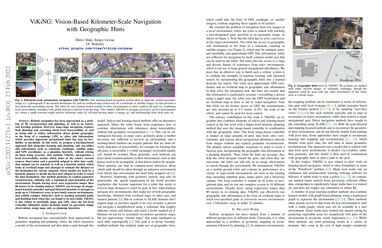ViKiNG: Vision-Based Kilometer-Scale Navigation with Geographic Hints
Robotic navigation has been approached as a problem of 3D reconstruction and planning, as well as an end-to-end learning problem. However, long-range navigation requires both planning and reasoning about local traversability, as well as being able to utilize general knowledge about global geography, in the form of a roadmap, GPS, or other side information providing important cues. In this work, we propose an approach that integrates learning and planning, and can utilize side information such as schematic roadmaps, satellite maps and GPS coordinates as a planning heuristic, without relying on them being accurate. Our method, ViKiNG, incorporates a local traversability model, which looks at the robot's current camera observation and a potential subgoal to infer how easily that subgoal can be reached, as well as a heuristic model, which looks at overhead maps for hints and attempts to evaluate the appropriateness of these subgoals in order to reach the goal. These models are used by a heuristic planner to identify the best waypoint in order to reach the final destination. Our method performs no explicit geometric reconstruction, utilizing only a topological representation of the environment. Despite having never seen trajectories longer than 80 meters in its training dataset, ViKiNG can leverage its image-based learned controller and goal-directed heuristic to navigate to goals up to 3 kilometers away in previously unseen environments, and exhibit complex behaviors such as probing potential paths and backtracking when they are found to be non-viable. ViKiNG is also robust to unreliable maps and GPS, since the low-level controller ultimately makes decisions based on egocentric image observations, using maps only as planning heuristics. For videos of our experiments, please check out our project page https://sites.google.com/view/viking-release.
PDF Abstract

